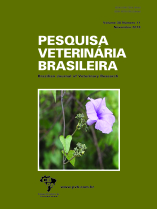 |
|
|
|
Year 2018 - Volume 38, Number 11
|

|
Causes of death in goats in Rio Grande do Sul state, Brazil: analysis of 322 cases (2000-2016), 38(11):2080-2087
|
ABSTRACT.- Bassuino D.M., Konradt G., Bianchi M.V., Snel G.G.M., Sonne L., Pavarini S.P. & Driemeier D. 2018. Causes of death in goats in Rio Grande do Sul state, Brazil: analysis of 322 cases (2000-2016). [Causas de morte em caprinos diagnosticadas no estado do Rio Grande do Sul: análise de 322 casos (2000-2016).] Pesquisa Veterinária Brasileira 38(11):2080-2087. Setor de Patologia Veterinária, Departamento de Patologia Clínica Veterinária, Faculdade de Veterinária, Universidade Federal do Rio Grande do Sul, Av. Bento Gonçalves 9090, Porto Alegre, RS 91540-000, Brazil. E-mail: davetpat@ufrgs.br
The diagnosis of the cause of death in goats submitted to necropsy from January 2000 to December 2016 by Setor de Patologia Veterinária from the Universidade Federal do Rio Grande do Sul was reviewed. Epidemiological features, such as the breed, sex and age, in addition to the clinical and pathological features were evaluated. During this period, 322 goats were necropsied, in which a conclusive diagnosis was obtained in 290 (90%) goats. Goats that were part of other experimental study were excluded from this study. From these 290 cases, 167 (57.6%) corresponded to diseases of infectious origin and toxinfectious diseases, while 123 (42.4%) were classified as non-infectious conditions. Infectious diseases included 55 cases of bacterial origin, 59 cases with parasitary involvement, 14 cases of viral origin, and 39 toxinfectious cases. Non-infectious conditions were grouped into metabolic diseases (44 cases), plants or chemical substances poisoning (36), mineral and nutritional deficiencies (20), and neoplasms and developmental disorders (5). In the remaining 18 cases, a conclusive diagnosis was obtained, however the conditions did not fit into those criteria and were classified as “others”. The age range of the goats in this study was from 1 day-old to 10 years-old. Most of the goats were females (201), while 121 were males. Affected breeds included Boer, Saanen, Anglo-Nubian, Toggenburg and mixed breeds. Parasitic, infectious and toxin-infectious diseases were the main cause of deaths, especially haemonchosis, pleuropneumonia, eimeriosis and enterotoxemia. Among the non-infectious conditions, metabolic disorders, especially rumen acidosis, pregnancy toxemia and urolithiasis, were directly related to the management employed in the property. Plant poisoning diagnosis was also highlighted with locally present plants, such as Sida carpinifolia, as the most important.
|
| |
|
|
| |
|
 |